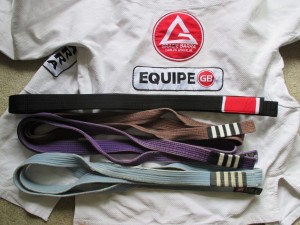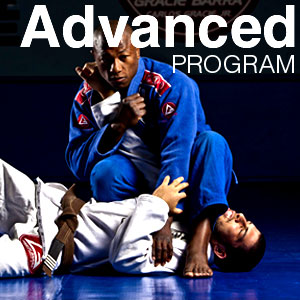The Evolution of Skill – From Fundamentals to Advanced
Sitting at the edge of the mat while watching students roll, I had a conversation with a newer student of bjj who was already a black belt in a traditional form of Japanese jiu-jitsu.
We were observing a couple of new students rolling; one of the students was unsuccessfully trying to pressure pass the other and they were locked in a stalemate with both burning tremendous amounts of energy.

I asked the Japanese bjj instructor what he saw in the dynamic of the match. He said something to the effect that the student trying to pass was not changing levels in his pass and unable to overcome the frame that the guard player was using defensively.
I agreed, but my view was even simpler: the passer only knew 1 guard pass well at this point in his study of jiu-jitsu, and used that pass for every situation. “When all one has is a hammer, every problem looks like a nail.”
We discussed some of the more advanced principles Article on Musashi and I shared my view of the stages of learning bjj. My view is that there are stages of understanding on jiu-jitsu that most students seem to pass through sequentially before being ready to progress to the next.  1) Focus on acquiring fundamental techniques for each position: The period of white belt where the student has developed mat fitness and become comfortable with the routine of classes is frequently the most exciting period of their training in bjj.
1) Focus on acquiring fundamental techniques for each position: The period of white belt where the student has developed mat fitness and become comfortable with the routine of classes is frequently the most exciting period of their training in bjj.
Every class reveals a new technique that is just the solution needed to address their problems in training. Every time the student steps on the mat they will gain another puzzle piece to their rolling.
The goal here is to equip the student with techniques to flesh out the positional hierarchy of bjj. They need to be able to identify what position they are in every part of the roll and have a solid technique they can employ to escape or control the position.
The Gracie Barra curriculum assists in making certain that the student will encounter each of these situations during the course of their time in the fundamental classes.
2) The correct mechanics: The student will understand the general way that a technique looks and works, but will now need to focus on the mechanics of the specific technique.
For example: when executing the Bull fighter guard pass, they will move beyond roughly grabbing the opponent’s legs, tossing them aside roughly and quickly running around to the side, hoping to secure side control before the opponent can recover the guard.
They now take a tighter grip on the knees: twisting the slack out of the opponent’s gi pants; they pin the opponents knees using their body weight to kill the opponent’s hip movement; they maintain pant grips to prevent the opponent from sneaking a knee inside and reguarding.
The student becomes aware that there are more efficient and technical ways to use each part of the mechanics of the technique. 3) Discovering other options for techniques: After several months / a year of bjj training, students will have at least one option from all of the main positions in bjj.
3) Discovering other options for techniques: After several months / a year of bjj training, students will have at least one option from all of the main positions in bjj.
Now, rolling is more productive as the students can attempt to utilize their techniques in the match – as opposed to strength and instinctive survival physical reactions.
One of the coolest things about bjj training is the enormous number of techniques and their variations in the art.
Earlier I mentioned “When all one has is a hammer, every problem looks like a nail.” Now, we acquire more hammers!
The guard position itself has many variations: (closed, butterfly, De la Riva, spider guard, Z-guard and so on). Now that the student is grounded in fundamentals, they can explore the infinite variations of positions.
Not to dampen your enthusiasm of studying new techniques, but the blackbelts will tell you that skill in jiu-jitsu comes not just from how many techniques that you know, but the depth to which you know your favorite ones.
4) Combinations and counters: Knowing the technique options that are available in specific training situations is the first step.
Early on, simply knowing more techniques than another inexperienced opponent may be enough to dominate the match.
It is at this stage of learning that the student starts to place the individual techniques in context.
They start thinking in terms of “When my opponent does this..is this the time to do that?” and “How can I set up my opponent for this technique?”.
Experienced practitioners can usually defend straight on single attacks and to be successful one must trick the opponent using distraction with the first technique in order to catch the second. 5) Return to the basics in depth: The majority of advanced belts (purple and above) that I speak with say that while they had experimented extensively with more advanced techniques, most were returning to those basic techniques they learned as new white belts.
5) Return to the basics in depth: The majority of advanced belts (purple and above) that I speak with say that while they had experimented extensively with more advanced techniques, most were returning to those basic techniques they learned as new white belts.
My own period spent as a brown belt was focused on 2 aspects of training: correcting some holes in my game and bringing my “basic” techniques – those movements that you use every time you roll – to a black belt level of technical precision.
By the time most practitioners have reached purple belt, they have seen most of the moves they will know as blackbelts. The difference between that purple belt and the black belt is the DEPTH to which they know the movement.
“Move your hip a little to the side and grip a bit deeper in the collar” are the types of details that move a basic technique into the black belt level.
You might say that the jiu-jitsu student has come full circle in their study of technique.
Credits: Mark Mullen
GB Black belt from GB Calgary, Canada
Twitter: @MarkMullenBJJ
